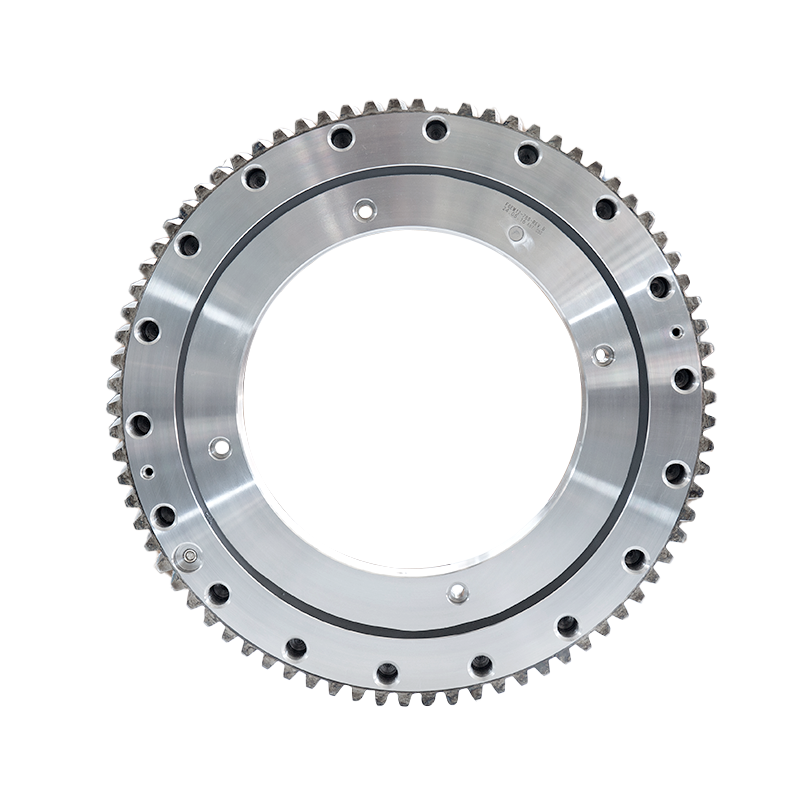How does the arrangement of the rollers in a three-row slewing bearing affect the bearing’s performance under high loads?
 2024.11.22
2024.11.22
 Industry news
Industry news
The arrangement of the rollers in a three-row roller slewing bearing plays a critical role in the bearing's ability to perform under high loads. Here's how the specific design and arrangement of the rollers affect the bearing's performance:
Load Distribution Across Three Rows
In a three-row roller slewing bearing, there are three distinct rows of rollers, each oriented to handle different types of loads:
Radial loads (perpendicular to the axis of rotation) are primarily supported by the first row of rollers.
Axial loads (parallel to the axis of rotation) are handled by the second row of rollers.
Tilting moments (bending or torque loads) are carried by the third row of rollers.
Effect on High Loads: The three-row design allows the bearing to distribute loads more evenly across multiple sets of rollers. This increases the bearing's load capacity, especially under high loads or combined loads (i.e., when radial, axial, and moment forces are applied simultaneously). This arrangement prevents overloading any single row and reduces the risk of localized stress or wear.
Increased Load Capacity
Higher Load Handling: By using three rows of rollers, the bearing can handle much higher radial and axial forces compared to single-row or double-row bearings. Each roller row shares the load, which means that the bearing can support larger or heavier loads without failure. This is especially important in heavy machinery such as cranes, wind turbines, or large excavators where high loads are common.
Load Sharing: The three rows share the total load, which means the individual load on each roller is reduced compared to a single-row design. This reduces the stress on individual contact points and helps prevent premature failure due to overloading.
Enhanced Stability and Resistance to Deformation
The multiple contact points (one for each row of rollers) help improve the bearing's stability and resistance to deformation. When a bearing is subjected to high loads, it’s crucial that it maintains its shape and alignment to prevent misalignment or binding. The three-row configuration ensures better load alignment, which is essential for maintaining smooth rotation and precision.
The ability to support high axial and radial loads while maintaining precision is particularly important in applications like precision machinery or turntables, where any misalignment can cause issues with function.
Increased Durability Under High Loads
Improved Distribution of Stress: The three-row design spreads out the forces more effectively, which not only increases the bearing capacity but also contributes to a longer service life. By reducing the wear on individual rollers and minimizing the occurrence of stress concentrations, the bearing is more resistant to fatigue and material degradation.
In cases where the bearing is subjected to varying or shock loads, the three-row arrangement helps distribute the shock, reducing the potential for sudden failures or damage.

Reduction in Roller Skewing or Misalignment
When a bearing is subjected to high loads, there is always a risk of roller skewing or misalignment. However, the design of the three-row roller slewing bearing helps prevent this by ensuring that each row of rollers supports a specific load direction (radial, axial, and moment). This reduces the risk of rollers shifting or misaligning, ensuring smoother operation even under high-load conditions.
Handling Combined Loads
The three-row arrangement is particularly effective when the bearing is subjected to combined loads—that is, when both radial, axial, and moment forces are acting simultaneously. The ability to handle all three types of forces simultaneously, with each row of rollers dedicated to one specific load direction, improves the bearing's overall load handling capacity and performance under complex conditions.
This capability is essential in applications like cranes, excavators, and wind turbines, where the bearing may be subjected to dynamic, multi-directional forces during operation.
Reduced Wear and Tear
In high-load situations, the ability to distribute forces across three rows of rollers leads to lower contact stress on each individual roller. This helps reduce wear and tear and prolong the bearing’s operational life, making it more reliable and cost-effective for long-term use.
Greater Resistance to Tilting Moments
The third row of rollers, which specifically handles tilting moments, allows the bearing to perform better under torque or bending loads. This feature is particularly important in applications where the bearing is expected to support large rotating or lifting loads that apply significant torque, such as in tower cranes or offshore equipment.
Summary:
The arrangement of rollers in a three-row roller slewing bearing allows the bearing to:
Distribute loads more evenly across multiple rows, improving its load capacity and stability.
Increase its load-handling capabilities, allowing it to manage high radial, axial, and moment loads simultaneously.
Enhance durability by reducing localized stress, wear, and deformation, which is especially beneficial under high-load conditions.
Improve resistance to misalignment and skewing, ensuring smoother, more precise operation.
Reduce wear and fatigue, increasing the bearing's service life and reliability.












